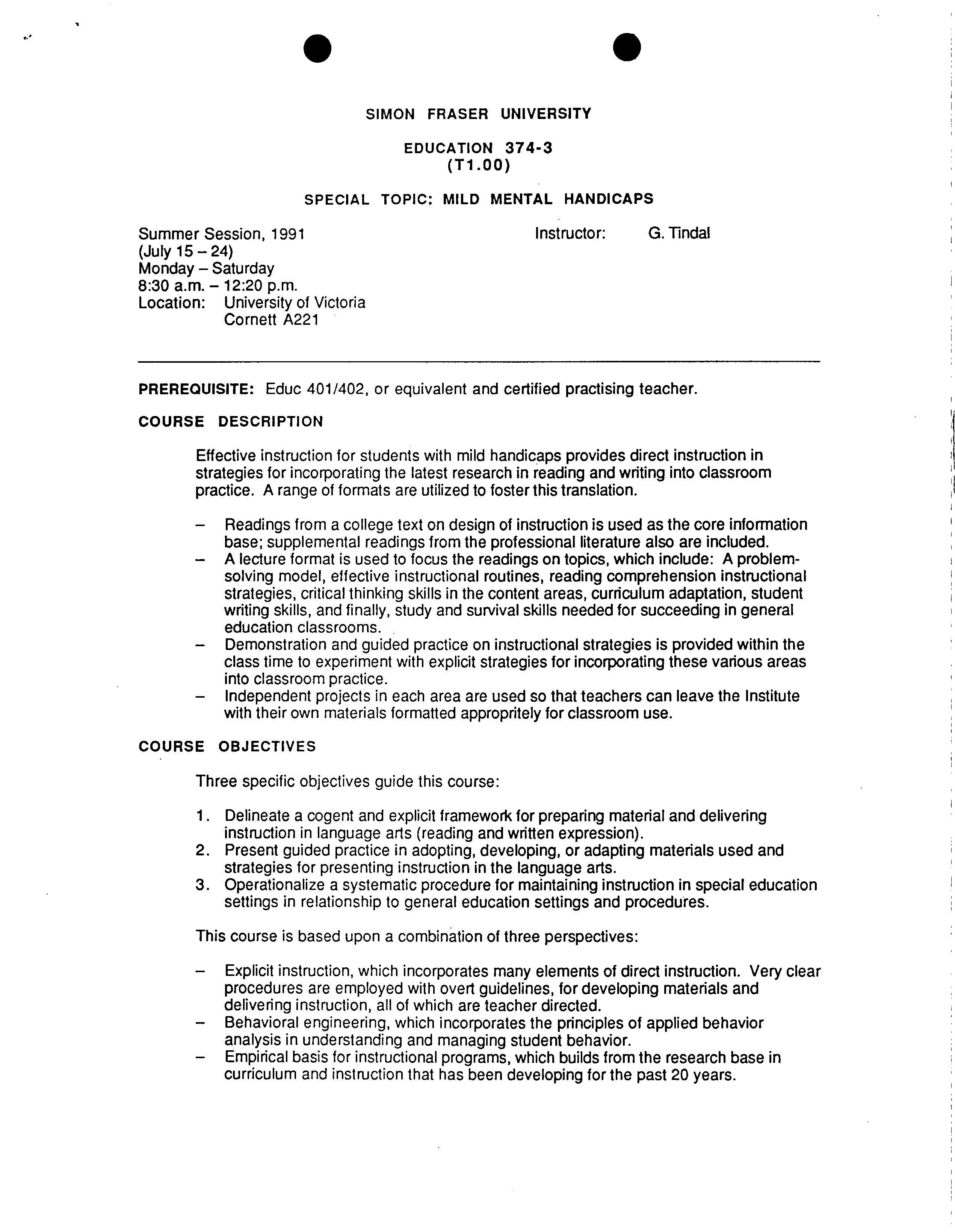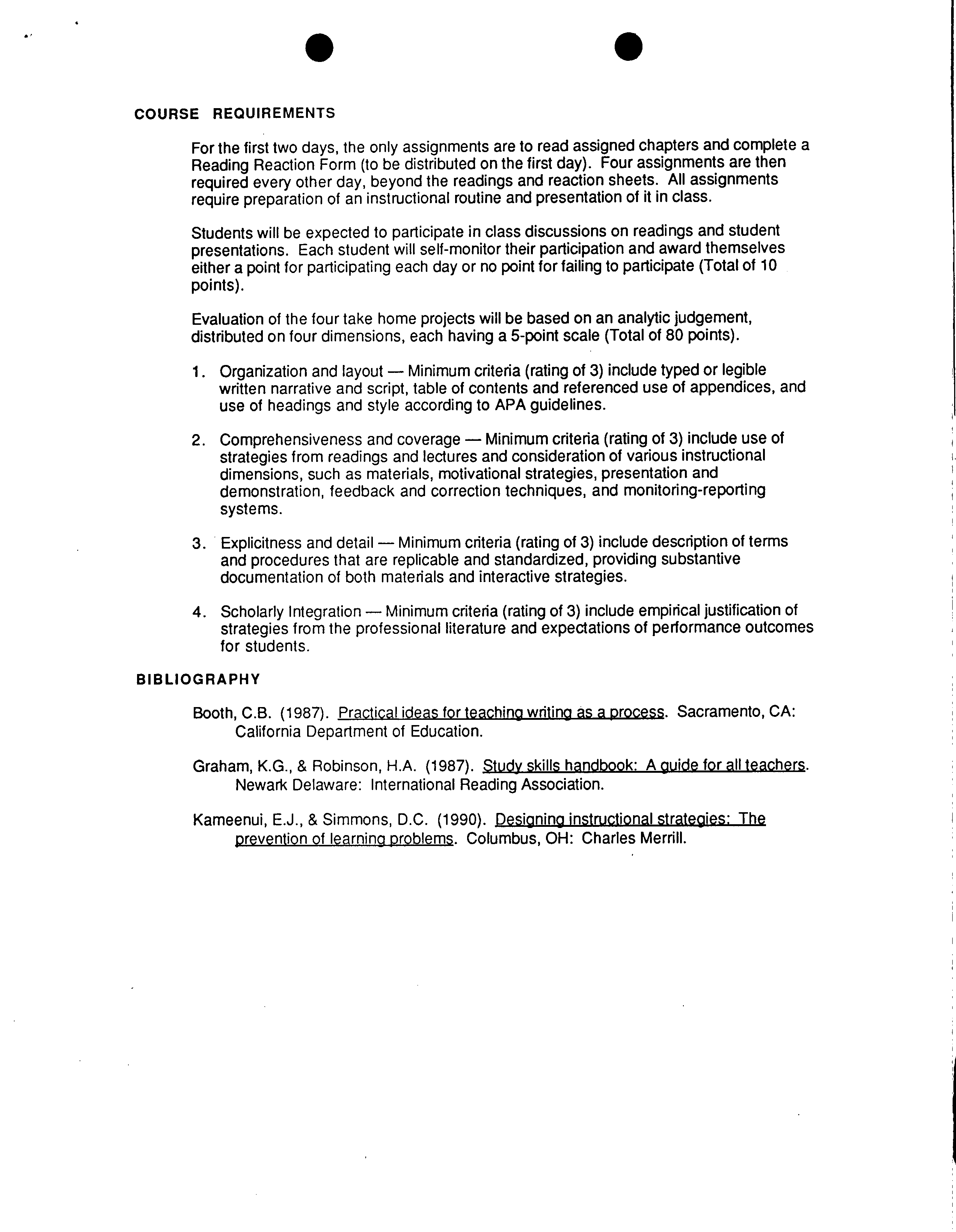S
SIMON FRASER UNIVERSITY
EDUCATION 374-3 ?
(T1.00)
SPECIAL TOPIC: MILD MENTAL HANDICAPS
Summer Session, 1991
?
Instructor: ?
G. Tindal
(July 15— 24)
Monday - Saturday
8:30 a.m. - 12:20 p.m.
Location: University of Victoria
Cornett A221
PREREQUISITE:
Educ 401/402, or equivalent and certified practising teacher.
COURSE
DESCRIPTION
Effective instruction for students with mild handicaps provides direct instruction in
strategies for incorporating the latest research in reading and writing into classroom
practice. A range of formats are utilized to foster this translation.
- Readings from a college text on design of instruction is used as the core information
?
base: supplemental readings from the professional literature also are included.
- A lecture format is used to focus the readings on topics, which include: A problem-
solving model, effective instructional routines, reading comprehension instructional
strategies, critical thinking skills in the content areas, curriculum adaptation, student
writing skills, and finally, study and survival skills needed for succeeding in general
education classrooms.
- Demonstration and guided practice on instructional strategies is provided within the
class time to experiment with explicit strategies for incorporating these various areas
into classroom practice.
- Independent projects in each area are used so that teachers can leave the Institute
with their own materials formatted appropritely for classroom use.
COURSE OBJECTIVES
Three specific objectives guide this course:
1.
Delineate a cogent and explicit framework for preparing material and delivering
instruction in language arts (reading and written expression).
2.
Present guided practice in adopting, developing, or adapting materials used and
strategies for presenting instruction in the language arts.
3. Operationalize a systematic procedure for maintaining instruction in special education
settings in relationship to general education settings and procedures.
This course is based upon a combination of three perspectives:
- Explicit instruction, which incorporates many elements of direct instruction. Very clear
procedures are employed with overt guidelines, for developing materials and
delivering instruction, all of which are teacher directed.
- Behavioral engineering, which incorporates the principles of applied behavior
analysis in understanding and managing student behavior.
- Empirical basis for instructional programs, which builds from the research base in?
curriculum and instruction that has been developing for the past 20 years.
.
?
S
COURSE REQUIREMENTS
For the first two days, the only assignments are to read assigned chapters and complete a
Reading Reaction Form (to be distributed on the first day). Four assignments are then
required every other day, beyond the readings and reaction sheets. All assignments
require preparation of an instructional routine and presentation of it in class.
Students will be expected to participate in class discussions on readings and student
presentations. Each student will self-monitor their participation and award themselves
either a point for participating each day or no point for failing to participate (Total of 10
points).
Evaluation of the four take home projects will be based on an analytic judgement,
distributed on four dimensions, each having a 5-point scale (Total of 80 points).
1.
Organization and layout - Minimum criteria (rating of 3) include typed or legible
written narrative and script, table of contents and referenced use of appendices, and
use of headings and style according to APA guidelines.
2.
Comprehensiveness and coverage - Minimum criteria (rating of 3) include use of
strategies from readings and lectures and consideration of various instructional
dimensions, such as materials, motivational strategies, presentation and
demonstration, feedback and correction techniques, and monitoring-reporting
systems.
3.
Explicitness and detail - Minimum criteria (rating of 3) include description of terms
and procedures that are replicable and standardized, providing substantive
documentation of both materials and interactive strategies.
4.
Scholarly Integration - Minimum criteria (rating of 3) include empirical justification of
strategies from the professional literature and expectations of performance outcomes
for students.
BIBLIOGRAPHY
Booth, C.B. (1987). Practical ideas for teaching writing as
p
process. Sacramento, CA:
California Department of Education.
Graham, K.G., & Robinson, H.A. (1987). Study skills handbook: A guide for all teachers.
Newark Delaware: International Reading Association.
Kameenui, E.J., & Simmons, D.C. (1990). Designing instructional strategies: The
prevention of learning problems. Columbus, OH: Charles Merrill.


